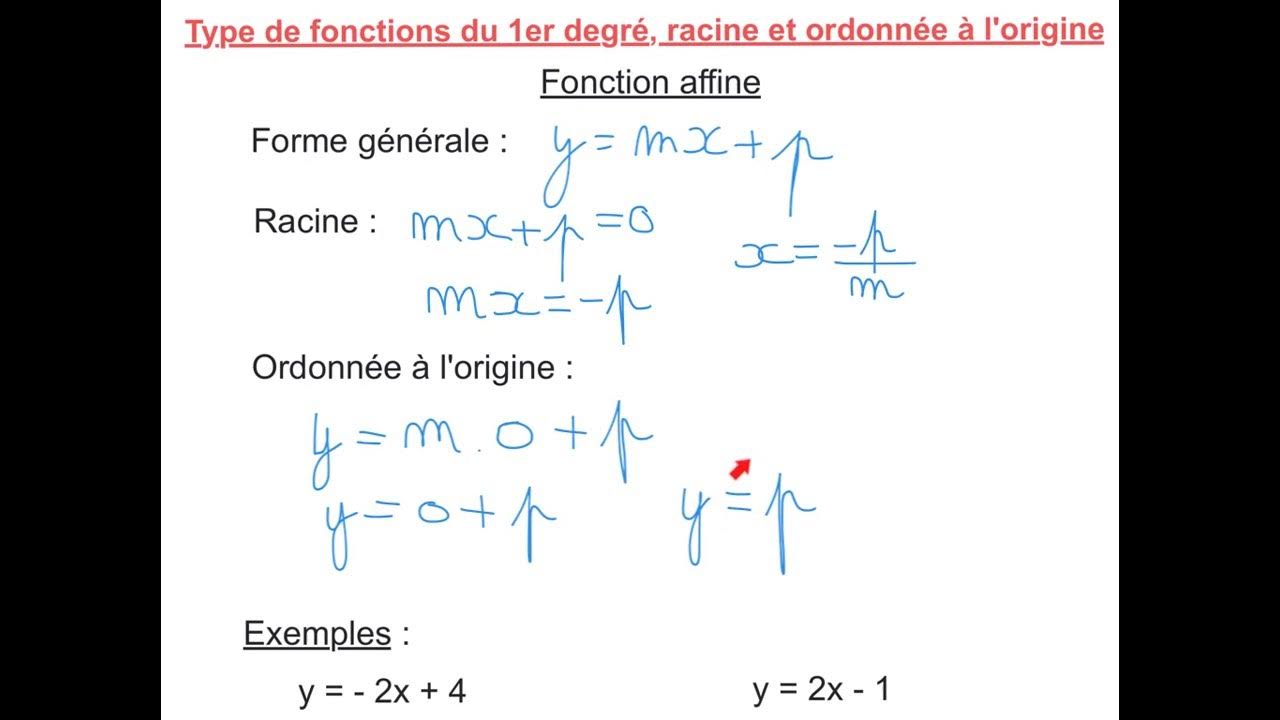FUNÇÃO AFIM - EXERCÍCIOS # 1
Summary
TLDRIn this educational video on first-degree (affine) functions, the instructor explains key concepts such as the general form of a first-degree function, how to determine values for constants like k, and the conditions for the function to be increasing. Practical examples are provided, including determining values of k in specific equations and understanding the difference between linear and affine functions. The video also covers graphing methods, emphasizing how to plot first-degree functions using points of intersection with the x and y axes. The session concludes with encouragement for viewers to engage with the content and continue learning.
Takeaways
- 😀 A first-degree (affine) function is in the form Y = Ax + B, where A cannot be zero.
- 😀 The term 'first-degree' refers to the highest power of the variable x in the function, which is 1.
- 😀 To make sure the function is in the first-degree form, ensure that the coefficient of x (A) is non-zero.
- 😀 In the example 2K - 1, we solve for k to ensure the function is first-degree: 2K must not equal 1, so k cannot be 1/2.
- 😀 To ensure a function is in the first-degree form, set expressions like k + 2 = 0, which gives k = -2.
- 😀 For a function to be increasing, the coefficient of x (A) must be positive (A > 0).
- 😀 In the inequality for an increasing function, solving 3k - 6 > 0 leads to k < 2.
- 😀 A linear function is a first-degree function where the constant term B equals zero (i.e., Y = Ax).
- 😀 To find the value of the coefficient A in a linear function, substitute given points into the equation and solve for A.
- 😀 Graphing a first-degree function involves selecting two x-values, calculating the corresponding y-values, and plotting the points to form a straight line.
Q & A
What is a first-degree function?
-A first-degree function, also known as an affine function, has the format Y = Ax + B, where A and B are constants, and A cannot be zero.
Why is a function with the form Y = Ax + B called a first-degree function?
-It is called a first-degree function because the highest power of the variable x is 1, which means it is a first-degree polynomial.
What is the role of the coefficient 'A' in a first-degree function?
-The coefficient 'A' in a first-degree function is the slope of the line. It indicates the rate of change of Y with respect to X, and it cannot be zero.
Why can't the coefficient 'A' be zero in a first-degree function?
-If the coefficient 'A' is zero, the equation would no longer be linear (it would become a constant function, Y = B), meaning there is no slope and no dependence on X.
How do you determine the value of K in the equation 2K - 1 so that it represents a first-degree function?
-For the equation 2K - 1 to be in the form of a first-degree function, K must be different from 1/2 because if K equals 1/2, the coefficient of x would be zero, making it not a first-degree function.
What condition makes a first-degree function increasing?
-A first-degree function is increasing when the coefficient 'A' is positive. This means that the slope of the line is positive, and as X increases, Y also increases.
In the equation Y = 17 - 3K - 6x, how do you determine the value of K for the function to be increasing?
-To make the function increasing, solve the inequality -3K - 6 > 0, which simplifies to K < 2. Therefore, the value of K must be less than 2.
What is the difference between a first-degree function and a linear function?
-A first-degree function has the general form Y = Ax + B, while a linear function is a special case where B = 0, meaning the function passes through the origin and can be written as Y = Ax.
How do you find the value of 'A' in a linear function that passes through the point (3, 2)?
-To find 'A', substitute the point (3, 2) into the equation Y = Ax. By substituting X = 3 and Y = 2, you get 2 = 3A. Solving for A gives A = 2/3.
What is the importance of the root of a first-degree function in graphing it?
-The root of a first-degree function is the X-value where the function intersects the X-axis (i.e., where Y = 0). This is important for graphing because it helps identify where the function crosses the axis and gives a point for the graph.
Outlines

Esta sección está disponible solo para usuarios con suscripción. Por favor, mejora tu plan para acceder a esta parte.
Mejorar ahoraMindmap

Esta sección está disponible solo para usuarios con suscripción. Por favor, mejora tu plan para acceder a esta parte.
Mejorar ahoraKeywords

Esta sección está disponible solo para usuarios con suscripción. Por favor, mejora tu plan para acceder a esta parte.
Mejorar ahoraHighlights

Esta sección está disponible solo para usuarios con suscripción. Por favor, mejora tu plan para acceder a esta parte.
Mejorar ahoraTranscripts

Esta sección está disponible solo para usuarios con suscripción. Por favor, mejora tu plan para acceder a esta parte.
Mejorar ahoraVer Más Videos Relacionados

FUNÇÃO AFIM | FUNÇÃO DO 1º GRAU | LEI DE FORMAÇÃO | AULA 1 - Professora Angela Matemática

13.2 Fonctions du 1er degré , racine et ordonnée à l'origine

VALOR NUMÉRICO DE UMA FUNÇÃO AFIM - FUNÇÃO DO 1º GRAU - AULA 2 - Professora Angela Matemática

ESTUDO DAS FUNÇÕES: FUNÇÃO AFIM - PARTE I ( AULA 3 DE 9 ) | MATEMÁTICA INTEGRAL

FUNÇÃO DO 1º GRAU: DEFINIÇÃO E GRÁFICO

FUNÇÃO DO 1º GRAU | COMO CONSTRUIR GRÁFICO | RAIZ DA FUNÇÃO
5.0 / 5 (0 votes)
